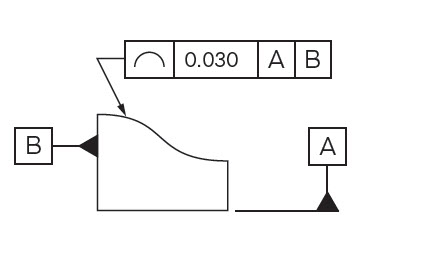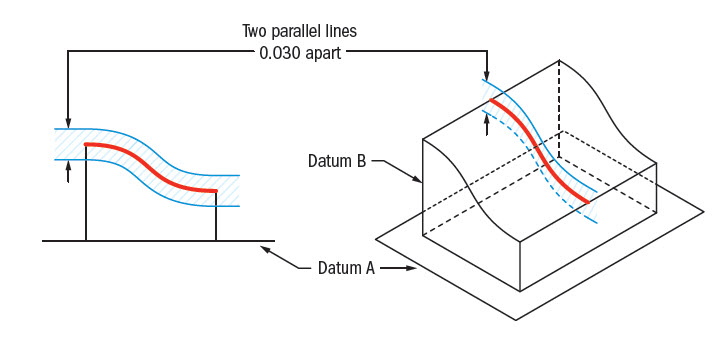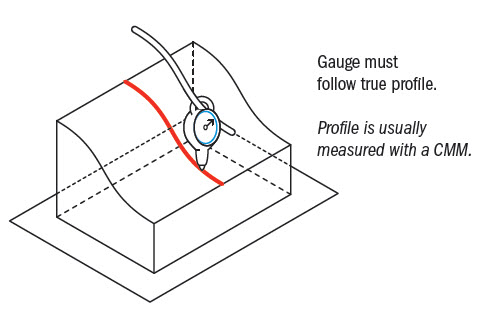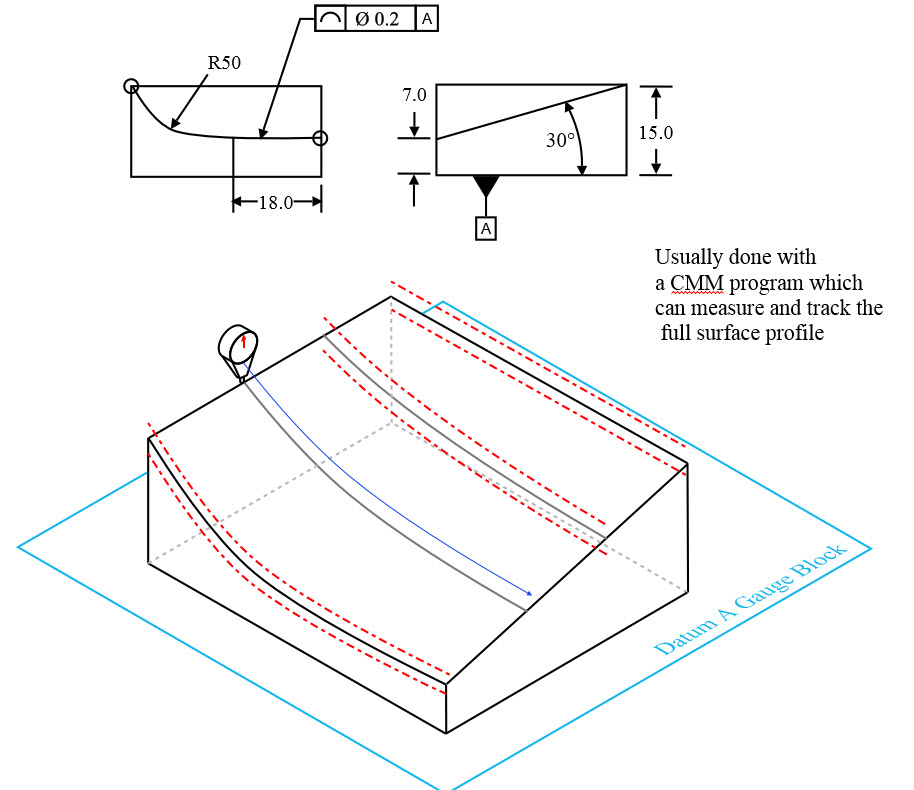GD&T Symbol: 
Relative to Datum: Optional
MMC or LMC applicable: No
Drawing Callout:

Description:
Profile of a line describes a tolerance zone around any line in any feature, usually of a curved shape. Profile of a line is a 2-Dimensional tolerance range that can be applied to any linear tolerance. If it is called out on a surface, like a radius on a part – profile of a line would specify how much that cross-section could vary from a true curved radius. Profile of a line takes a cross section at any point along the surface and sets a tolerance zone on either side of the profile. The profile of a line callout can also be set with an all-around leader or given a specific range (see example).
GD&T Tolerance Zone:
2-Dimensional tolerance zone existing of two parallel curves that follow the contour of the true surface profile. The application on where the tolerance zone applies can be specified on the drawing. This tolerance zone may or may not be referenced by a datum.

Gauging / Measurement:
Profile of a line is measured using a gauge that is referenced to the true profile at the given specific cross-section. Because there are an infinite amount of 2D cross-sections of any part, the number or locations of measurement points can be specified on the drawing. Profile is usually measured using a CMM for more complex geometries.

Relation to Other GD&T Symbols:
Profile of a line is of course closely related to profile of a surface. The difference being that profile of a line takes only the measurement at a specific cross-section and does not take into account the variance of one cross-section to the next.
Profile of a line can also be thought to be similar to straightness or circularity. All three tolerance symbols specify how much a cross-section can vary whether in a straight line, a circle or in a custom profile shape. They all have a tolerance zone existing of parallel lines surrounding the measured profile in a 2-Dimensional cross-section.
When Used:
Profile of a line is used for advanced curved surfaces, such as when a feature curves in multiple axes at once. A common use of line profile would be if you were comparing a curving surface such as the hood of a car, or an airplane wing. With an airplane wing, each cross-section would need to be a different profile shape and require multiple measurements to ensure at each location the profile tolerance is met. Both profiles of a line or profile of a surface can be called out on such surfaces.
Example:
If you have a curved surface that would need to be in specification along all of its cross-sections as shown below.
This could be considered an advanced curve that could only be controlled with the use of a profile tolerance if required. The part is only measured from point C to D for each cross-section.
Note: The profile of a line tolerance does not control the specific dimension that every surface point is located – that is done by the dimensions of the part. It only controls how tightly the points fall into a “true” curve, similar to the circularity tolerance.
Final Notes to Remember:
Used with Surface Profile:
Sometimes profile of a line is used in conjunction with profile of a surface. In these cases, the line profile tolerance will be tighter than the surface tolerance. This ensures that along any specific cross section of the profile, the profile remains true, while also ensuring that each cross section of the part would be within a wider tolerance range when compared together.
Be The Go-To Engineer at Your Company
Learn GD&T at your own pace and apply it with confidence in the real world.
Get GD&T Training














































Hi matt,
Can we put basic dimensions with profile of line tolerance called out ,
As profile tolerance controls the deviation of profile from true value , like position tolerance,
Ashok –
Profile controls (line or surface) with no datums are nothing more than form controls (such as flatness, straightness etc.). It’s only after adding a datum structure that you start to control orientation and location. As such, when you control location you need to include basic dimensions from the referenced datums.
Hope this clears things up, good luck!
Matt
Which instrument is used to measure Profile of line
on a drawing i have , Surface Profile 0.5 E |A|B|C The E its means that its only for one size? Normal it is ±0.25 each side.
Mark –
You have me stumped. There is no use of the symbol ‘E’ at all in the ASME Y14.5 standard and my quick flip through the ISO standard isn’t revealing any use of it either. Can you look at the bottom right of the drawing and tell me what dimensional standard the drawing should be interpreted to? Is it possible that the drawing is in error? Get back to me.
Matt
Hello,
Can the dimensional tolerance ±0.020 2 be interpreted as profile 0.040″ to check the feature using Go-No go gauge. Please advise ?
Pram –
In certain instances, yes. The default tolerance for all profile controls is an equal bilateral distribution about the true profile. In this specific instance your effective tolerance is +/- .020 or profile to .040.
Remember that the profile control specifies the total amount of tolerance available. Take note that either depicting an alternative tolerance disposition on the part (with dimensions) or making use of the unequally disposed profile symbol (circle U) changes how the tolerance is applied. The tolerance value after the circle U indicates the amount of tolerance given in the direction that adds material (makes the part heavier) to the part.
For instance, if you have | profile | .040 (U) .010 |, this means that you’re tolerance for an external surface feature would be +.010 / -.030.
I hope this helps clear things up.
Cheers,
Matt
Some good information
my question is how do you report deviation for a profile.
I ‘ve seen it different ways depending on the customer.
1) double worse case
2) report min/ max
is there a standard
Nick –
I’m not sure what you mean. I’m an engineer by trade not an inspector. Profile tolerances are a binary type tolerance, they are either in or they are out. Think of it as the double-fenced perimeter around a prison.. You’re surface has to be within the limits of the two ‘fences’ or the part is rejected. Given that most inspections these days are done with a CMM probe where you are tracing the contour of a part and comparing that to a digital onscreen boundary, I honestly couldn’t tell you what the output would be. Even the old school method of having a gage built with two painted lines indicating your inner and outer boundary profiles wouldn’t give you a hard number to report, just a pass fail. (I’m envisioning a square part with a boxing ring shaped gage with two sets of ‘ropes’ an inner and an outer. You place your part in and align your datums, if any part of the surface breaks a boundary it’s a part reject, but there is no hard associated number).
I hope this helps.
Cheers,
Matt
Hello all, I have a question. We have great debates how to read the following tolerances:
True position | 0.5 | A | B-B |
Profile of the surface | 0.1 |
Is the profile of the surface connected to the true position or not?
Thank you in advance
Imre –
I’m not quite sure what you mean when you say connected. Whenever you have a profile control without any datums it is acting like a form control. Recall that form controls are flatness, straightness, circularity and cylindricity. Without seeing any further about your specific case I’m guessing here:
For the composite control you are describing, you are locating a feature within a zone of 0.5 relative to datums A and B-B. Then you are also saying that the form of the feature has to simultaneously be within a zone of 0.1. I’m assuming that with the control you’re describing you’re talking about a slot or a tab and not a whole.
My issue with the way this control is called out is that the Positional Tolerance is controlling the axis or mid-plane of the feature while the profile control is acting on the surface. I don’t believe that having them together is appropriate without actually seeing how you’ve applied it.
I hope this helps.
Cheers,
Matt
Hi,
Thank you for the great website. It is my go-to reference for all my GD&T questions.
It would be great if you can provide an example of this: “The profile of a line callout can also be set with an all-around leader”?
Another question: In the example above, how should I interpret the diameter symbol at the profile call out? Without it, I would interpret it as two parallel profile being 0.2 apart.
which leads me into this question: “true position” is the only callout that might require a cylindrical tolerance zone? i.e. require the use of the diameter symbol?
Thanks in advance,
Jerry
Jerry –
Glad you enjoy the website. You should check out the pricing for our courses. We have both beginners and advanced course options, depending on your skill level.
To address your question, you are not allowed to use the diameter symbol with either of the profile controls. Profile controls only apply to the indicated surface for the entire depth (into the page) of the part. Take your pencil and draw the letter L, use a nice fat radius for the transition instead of the 90 angle. If you point the profile control to the lower line segment, the control stops where the transition radius begins and only applies to the lower segment. Had you pointed it to the radius it would not have applied to either the vertical or horizontal segment.
Now, if you place a circle around the ‘knee’ of the leader line you are indicating it applies around the entire perimeter of the part in the view it is applied to. Going back to our L example it would apply to a total of 8 surfaces, i.e. Horizontal Segment (right face, upper and lower surface), Radius (upper and lower surfaces) and the Vertical Segment (left and right surfaces and upper face).
I hope this helps.
Cheers,
Matt
Hi Matt,
Thank you for the reply and answers to my questions.
Excellent example on the “L”! Well explained!
I take that it must be a misprint on the example above, where it is indicating a profile call out of dia0.2 to datum A.
Yes I have taken your on-line courses a year or two ago!
Thank you once again!
Jerry
Jerry –
Yes, that is a mistake that we’ll have to circle back and correct. If it’s been a while since you’ve taken our intro to GD&T course we are now offering an advanced course that covers topics like composite positional tolerance, multiple single segment tolerance in addition to better preparing you for the ASME Y14.5 Sr. Level exam. We are continually adding content and the lesson database is growing. If nothing else take a look at the syllabus online and see if it isn’t a good fit for you.
Cheers,
Matt
Hi…..
I have a customer drawing calling our for line profile of 0.2 (without datum). It is a grooved surface. The customer also demands that depth of groove to be maintained within +/- 0.15mm. Can u Pl help me understand interpretation of this dimensioning?
Also, I need to understand if while measuring line profile, do we need to pass best fit curve from the actual traced curve or use basic nominal profile at mean tolerances?
Thanks in advance
Thanks for creating such a website. Detailed explanation in very simple language. So far the best articles that I found on internet.
Glad you like it! We go into much more detail for all of the controls in the GD&T Basics Course and we are currently working on creating an advanced course that will be available later this year. In less than a year and a half we have had over 1,000 students, machinists and engineers take our course!
Cheers,
Matt
if we have .030 Profile of a Line callout like this what is the max and min. tolerance?
Is the tolerance +/- .015?
Or is it tol. min .000 and tol. max .030?
Ernie –
The default disposition is equally bi-laterally about the true (as drawn) profile. That is, the tolerance is +/- .015 for a total of .030. The way to modify this per the 1994 standard is to illustrate on the part with dashed lines +.010/-.020 over the region you want to control. In the 2009 standard they added a handy modifier ‘circle-u’ or (U) that is added after the tolerance value in profile controls. The number directly after the circle – u is telling you the amount of tolerance to be applied in the direction that ADDS more material (i.e., weight) to the part.
Note, you can still use the method from the 1994 as an alternative practice, but it tends to make for messy drawings.
THANK YOU FOR CLEARING THIS UP.
This has been wrecking havoc in my workplace for a while now.
I want to outline my scenario for a better understanding.
Its a profile of line of 0.06 for a basic dimension of radius of sphere of X value.
This being said, our customer calls that the dimensional tolerance be maintained +-0.03. What we propose is that the dimensional tolerance be relaxed to +-0.06 but maintaining the profile of line within 0.06. Is this a valid discussion or are we missing something here. I am under the understanding that the geometric tolerance specifies a bandwidth that is within the dimensional tolerance for better control. that being the case, +-0.06 with a profile of line of 0.06 will be enough to ensure meeting the requirement.
Hoping for your reply to clear things up.
Thanks again for a wonderful site and explanation.
Regards
Yamunai –
You’re talking spherical radius, so I’m thinking of something like a ball bearing or a ball and socket joint in your hip. Calling out profile of a line means that your control only applies in the direction shown on the print. Zoomed way in it would essentially look like the layers a 3D printer would make as it prints a sphere.
Now, if you are using either profile of a line or profile of a surface and call out datums the dimension of size MUST be basic. If no datums are called out your profile control (surface or line) is considered a form control and MUST be a refinement of the size tolerance.
The way the profile controls work are that the tolerance is equally disposed about the true profile as shown on the drawing, unless stated otherwise. Based on your comments it almost sounds as though you are trying to use the profile to refine the surface while still allowing the actual size to vary. Re-stated your radius could have a nominal size of X, a max size of X+0.06, and a min size of X-0.06. Now, wherever your radius winds up you are stating that you want a line profile control of 0.06. Keep in mind that your limits of size must be respected first and foremost. Therefore, if you produce a part at max size (X+0.06) your surface variation from profile can only be +0/-0.03. Likewise, at min size your surface variation from profile could only be -0/+0.03. As your produced size moves away from either MMC or LMC you could have greater variation in profile.
I hope I’ve answered your question. If I’ve missed the mark let me know. If you need to scan an image to my email address at .
Cheers,
Matt
can we able to use profile tolerance instead of form tolerance ?
Naresh –
Absolutely, when a profile tolerance is specified without any datums it is considered a form control.
Cheers,
Matt
when profile of line is used corresponding locating dimensions must be basic? as like as profile of surface?
Shiva –
This is a frequently misunderstood concept of profile controls. You may use either basic or toleranced dimensions to locate the true profile about which the profile controls is applied. When can you use one versus the other?
If the true profile is located with toleranced dimensions then the profile tolerance must be a refinement of the dimensions that locate the true profile.
If the true profile is located with basic dimensions then the true profile must relate back to any referenced datums with those basic dimensions.
That being said, life is just much easier if basic dimensions are used with profile controls. It reduces the chance of a misunderstanding. Also, it is rather rare to see a line profile control by itself. Usually it is a refinement of a surface profile control as part of a multi-single segment control.
Hopefully this clears things up a bit. Let us know if you have further questions.
Cheers,
Matt
Hi, I have a question. I received from a customer a drawing with the following callout for the external profile (it is a thin flat rectangular part in aluminium), but I am not sure if that is fine due to I understand that a Profile of a Line the MMC and LMC don’t apply and it should be only controlled for the basic dimension. Am I wrong?
profile of a line|0.5|A|B mmc|C mmc|
I wasn’t able to paste the symbols here for that reason I put the names, I hope you understand.
Thanks for your help.
When the MMC or LMC modifiers are used after a Datum the meaning is entirly different. It is a more advanced topic in GD&T but it is called Maximum Material Boundary. What your drawing is stating is that your profile should be inspected by securing datum A. Next though you would need to simluate datum B when it is in its maximum material condition. This means that if datum B is a hole, your simulator would control it at its smallest size (MMC). When refereing to a datum this is known as its max material boundary. The goal is to simulate a datum condition at its worst case so that the profile feature AND the datum must all be able to assemble in the worst condition. We cover this in our GD&T course when we go over functional gauging. It is probobly more common with Position, but profile can also have a feature or a surface be measured in its Max Material Boundary (or Least)
Please clarify if we can use “profile of a line” to define an axis or a central plane of a groove of constant cross-section, that runs in a trajectory thats made of curves and straight lines. Imagine something that eventually ends at the starting point.
Profile of a line only applies to surfaces in the ASME Y14.5 You can use a position tolerance to define the location of an axis or midplane
thank you sir….now my doubt has been cleared.
thanks a lot sir
Thanks Vikas, We are happy to help!
Hello,
After looking for this info, about profile tolerances, I finally solved my biggest doubts with your explanation, thank you very much for that. But there is something I still don’t get. In which cases would I dispense the use of a Datum? When you use it, is it used only to know where to put the gauge?
Thanks in advance for your response.
Best regards,
Lizardo De Las Casas
Sorry, I meant “dispense with”
Profile without a datum is similar to the form tolerances. The Form of the profile needs to be maintained, but the orientation and location can be anywhere in space as long as your other dimensions are in specification. Profile is a catch-all symbol and can be used to control form, (no datums) orientation (1-2 datums) location (2-3 datums) and size (using basic dimensions).